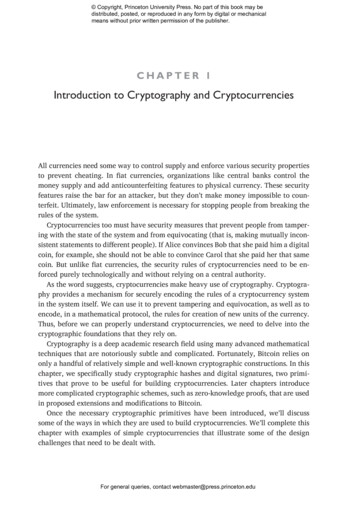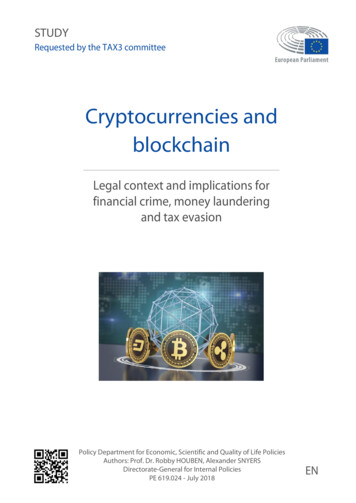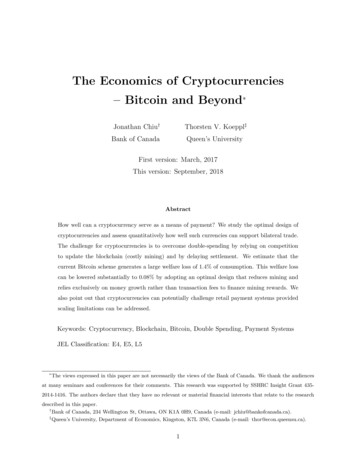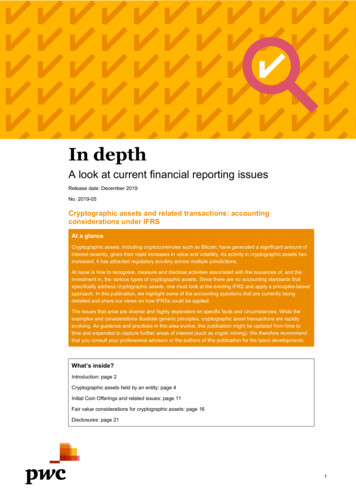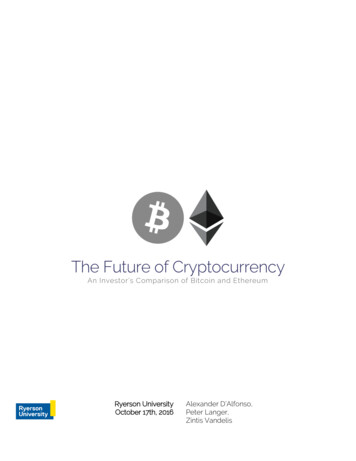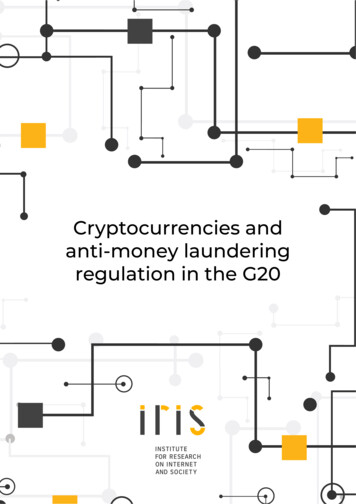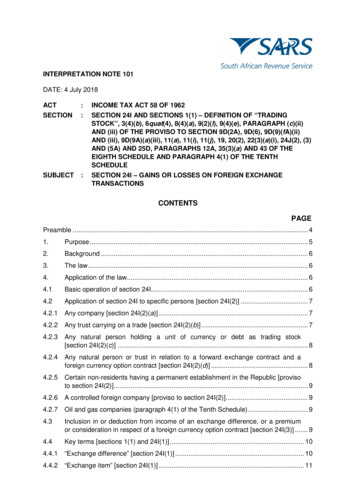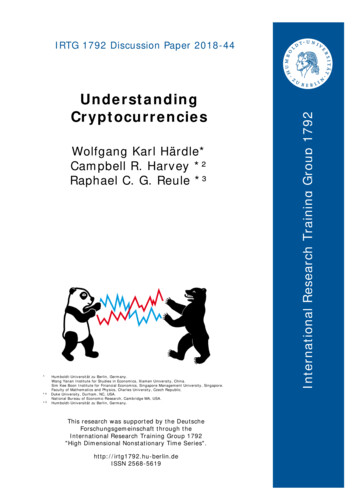
Transcription
UnderstandingCryptocurrenciesWolfgang Karl Härdle*Campbell R. Harvey *²Raphael C. G. Reule *³**²*3Humboldt-Universität zu Berlin, Germany.Wang Yanan Institute for Studies in Economics, Xiamen University, China.Sim Kee Boon Institute for Financial Economics, Singapore Management University, Singapore.Faculty of Mathematics and Physics, Charles University, Czech Republic.Duke University, Durham, NC, USA.National Bureau of Economic Research, Cambridge MA, USA.Humboldt-Universität zu Berlin, Germany.This research was supported by the DeutscheForschungsgemeinschaft through theInternational Research Training Group 1792"High Dimensional Nonstationary Time Series".http://irtg1792.hu-berlin.deISSN 2568-5619International Research Training Group 1792IRTG 1792 Discussion Paper 2018-44
Understanding CryptocurrenciesWolfgang Karl HärdleHumboldt-Universität zu Berlin, Germany.Wang Yanan Institute for Studies in Economics, Xiamen University, China.Sim Kee Boon Institute for Financial Economics, Singapore Management University, Singapore.Faculty of Mathematics and Physics, Charles University, Czech Republic.haerdle[at]hu-berlin.deCampbell R. HarveyDuke University, Durham, NC, USA.National Bureau of Economic Research, Cambridge MA, USA.cam.harvey[at]duke.eduRaphael C. G. ReuleHumboldt-Universität zu Berlin, Germany.irtg1792.wiwi[at]hu-berlin.de3rd August 2019AbstractCryptocurrency refers to a type of digital asset that uses distributed ledger, orblockchain, technology to enable a secure transaction. Although the technologyis widely misunderstood, many central banks are considering launching their ownnational cryptocurrency. In contrast to most data in financial economics, detaileddata on the history of every transaction in the cryptocurrency complex are freelyavailable. Furthermore, empirically-oriented research is only now beginning, presenting an extraordinary research opportunity for academia. We provide some insightsinto the mechanics of cryptocurrencies, describing summary statistics and focusingon potential future research avenues in financial economics.JEL Classification: C01, C58, E42, E51, G10, K24, K42, L86, O31Keywords: Cryptocurrency, Blockchain, bitcoin, Economic bubble, Peer-to-Peer, Finance,Cryptographic hashing, Consensus, Proof-of-work, Proof-of-stake, VolatilityT he f inancial support of Czech Science F oundation under grant no. 19 28231X isacknowledged.1
1IntroductionIn 2008, the pseudonymous “Satoshi Nakamoto” posted a white paper describing animplementation of a digital currency called bitcoin that used blockchain technology. Morethan ten years later, hundreds of cryptocurrencies and innumerable other applications ofblockchain technology are readily available.The rise of cryptocurrencies poses an existential threat to many traditional functionsin finance. Cryptocurrencies embrace a peer-to-peer mechanism and effectively eliminatethe “middle man”, which could be a financial institution. For example, no bank account orcredit card is needed to transact in the world of cryptocurrencies. Indeed, a cryptocurrency“wallet” serves the same function as a bank vault. With a smart phone and the internet,the potential exists for a revolution in financial inclusion — given that over two billionpeople are unbanked (GlobalFindex, 2017; World Bank, 2017).The technology, however, goes well beyond providing banking services to the unbanked.It holds the potential for cheap, secure, and near-instant transactions, allowing billionsof people to join the world of internet commerce, paying, and being paid, for goods orservices, outside of the traditional banking and credit card infrastructure.Cryptocurrencies transactions potentially enable near real-time micropayments. Creditcards are not designed to be used for a one-cent charge to download, for example, aproduct or service from the internet. Cryptocurrency systems promise to make micropayments seamless and allow businesses to offer real-time pay-per-use consumption of theirproducts, such as video, audio, cell phone service, utilities, and so forth.A cryptocurrency like bitcoin can be thought of as a decentralized autonomous organization (DAO), an open-source peer-to-peer digital network that enforces the rules it isset up with. In this DAO setting, the money supply is set by an algorithmic rule,and the integrity of the network replaces the need to trust the integrity of humanparticipants. The growth of crypotcurrency technology therefore poses a challenge totraditional monetary authorities and central banks, as Facebook’s “Libra” coin preemission market acceptance suggests (Taskinsoy, 2019). Central banks understand this,and many banks have initiated their own national cryptocurrency initiatives (Bech andGarratt, 2017).As with any new technology, risks are present. In the nascent cryptocurrency market,one concern involves the anonymous nature of transactions in some cryptocurrencies,which could allow nefarious actors to conduct illegal business, or worse, to pose a broader2
threat to our society and institutions (Foley et al., 2018). The benefits, such as lowtransaction cost, security and the promise of quick processing, are readily measurable,but quantifying the risks is less straightforward.In our view, any new technology involves risks; if we require no risk, innovationis constrained (Catalini and Gans, 2016). Cryptocurrencies have, in contrast to manymarkets, a plethora of available and free data, ripe for empirical investigation. We arejust now seeing the genesis of academic research focusing on this emerging technology(Harvey, 2014, 2017a, 2017b; Härdle et al., 2018; Kim et al., 2019).We have four goals in this paper. First, we explain the mechanics of cryptocurrenciesat a high level. Second, we detail useful data sources for researchers. Third, we providebasic summary statistics given the available data. Finally, we offer a list of possibleresearch applications.2Cryptocurrencies and BlockchainsThe concept of supplementary (Delmolino et al., 2016), alternative (Ametrano, 2016), ordigital currencies (Chaum, 1983) is not new, but the concept of an open-source currencywithout a central point of trust, such as a central distribution agency or state lead control,is new (King and Nadal, 2012). A cryptocurrency is a digital asset designed to work as amedium of exchange using cryptography to secure transactions, to control the creation ofadditional value units, and to verify the transfer of assets. Many different cryptocurrenciesexist, each with their own set of rules, see, for example, coinmarketcap.com (Iwamuraet al., 2014; Abraham et al., 2016; Bartos, 2015; Park et al., 2015). Differences amongthe cryptocurrencies may involve, for example, the choice of the consensus mechanism,the latency, or the cryptographic hashing algorithms.2.1High-level description of blockchainAbadi and Brunnermeier (2018) describe a blockchain trilemma, i.e. that no ledger cansatisfy all ideal qualities of any recordkeeping system — correctness, decentralization,and cost efficiency — simultaneously. Yet, a blockchain is more efficient than a centrallymanaged traditional ledger (Babich and Hilary, 2018a). A blockchain can be implementedin many ways, but most share several common features. We can think of a blockchain asa very special database. A blockchain’s structure is shared, or distributed, rather thancentralized, and thus is often referred to as distributed ledger technology (DLT). Figure 1shows a distributed network. As we discuss later, the distributed network provides somelevel of security, because it is unlikely an attack can be launched on every copy of the3
database. Distributed databases are not new, and most distributed databases are notblockchains. The key difference between a regular distributed database and one set on ablockchain is the structure (Babich and Hillary, 2018b).A blockchain is divided into subsheets of data, each one called a block. At the end ofeach block is a digest that summarizes the contents of the block. The digest is repeatedas the first line of the next block. If any change is made in the content of a historicalblock, the digest changes for that block and it will not match the first line of the nextblock. When the network detects such an inconsistency, it throws out the corruptedblock and replaces the block with the original. In this sense, the database is immutable.Given this structure (i.e., data organized in blocks with updates to the blockchain beingappend-only, based on the respective consensus mechanism), it is extremely unlikely thathistory can be rewritten. The digest at the end of a block and at the beginning of thenext is generated by a cryptographic hashing function.(a) Centralized(b) Decentralized(c) DistributedFigure 1: Types of networks.All presented numerical and pictoral examples shown are reproducible and can befound onwww.quantlet.de (Borke and Härdle, 2018).2.2HashingA hash function is a one-way mathematical algorithm that takes an input and transformsit into an output, known as the hash or digest. Hashing functions have a long history incomputer science and are integral to the blockchain technology. Hashing should not beconfused with encryption. With encryption, a file is encrypted with a key and decryptedwith a key. Hashing has no decryption step. Additionally, a good hashing algorithmmakes it computationally infeasible to find two input values that produce the same hashvalue (output); this is known as collision resistance (Paar and Pelzl, 2010; Derose, 2015;Harvey, 2016).4
One common cryptographic hashing algorithm, the Secure Hash Algorithm (SHA256), has a maximum input size of 264 -1 bits (more than 2 million terabytes) and anoutput of 256 bits. We usually represent the SHA-256 output in hexadecimal form, alsocalled base 16 (the characters 0-9 and a-f). In order to make the theoretical maximal inputsize more visual, we assume that 1 bit equals to 1 mm2 . A soccer field has the dimensionsof 7,140 m2 , therefore 264 -1 bits could theoretically fill 2,583,577,601 soccer fields. As thewhole surface of the earth equals to 510,000,000,000,000 m2 , we could also cover around36170 times the earth with the theoretical input size. This input information will bestored in a very short output, the hash. If just one piece of the input, like for example ablank space or a comma, is changed, then the hash output be completely different.Importantly, the digest does not reveal the original information. For example, supposewe want to send an electronic document via email, but are worried that the documentcould be corrupted and the content altered. One way to verify the integrity of the emailis to use a hashing function, such as the SHA-256. Before sending the email, we obtaina SHA-256 of the document and post the SHA-256 on our website. We then send thedocument. The recipient also hashes the document to verify the hash is the same as thehash on our website. If they are identical, we have securely sent the document. Postingthe hash on our website does not reveal the content of the email.Here are some examples, which you can try by using the R package “digest”, the Pythonlibary “hashlib”, or many online programs such as interactive Github-based repositories.Input: Hello CRIXOutput: 94308ceaf93761Input: Hallo CRIXOutput: 6a7fd3e518ec65Note that changing a single letter from “e” to “a” completely changes the hash.2.3BlockchainsHaber and Stornetta (1991) were the first to propose a linear hash chain or blockchain.They solved the problem of how to certify when a digital document was created or lastchanged by timestamping a cryptographic hash of the document. By not timestampingthe data itself, the privacy of the content was preserved. Haber and Stornetta’s timestamping proposal also solved the potential problems of collusion and lack of trust bylinking hash values together and using digital signatures, which uniquely identify thesigner.5
A year later, Dwork and Naor (1992) proposed a proof-of-work system to combat junkemail. Their idea was to provide each email with a header containing virtual postage inthe form of a single calculation, which the receiver could verify with very little effort.This postage stamp was to be proof that a modest amount of CPU time was expendedfor calculating the stamp prior to sending the email. Whereas an individual email couldbe sent at a very low cost, the intent was to defeat spammers, who send millions ofemails. Spamming would come at a high price. Back (2002) coined the term hashcashto describe this proof of work, the computational cost of producing each hash, a termfirst used by Jakobsson and Juels (1999).Many applications of blockchain technology exist, but we focus our attention oncryptocurrencies. Bitcoin (cryptocurrency known as BTC) was the first example of adigital asset, which has no backing or intrinsic value, based on blockchain technology(Nakamoto, 2008; Böhme et al., 2015, for a review).A common characteristic of cryptocurrencies is a network of peers with equal standing.Each participant has a copy of the ledger and offers an algorithmic consent on the correctledger (i.e., which new block is accepted and which block is rejected to form a new partof the blockchain). It is unneccesary to know your peers in a blockchain or to trust them.It is also possible to design a blockchain so that only specific trusted parties have theability to add to the ledger. Private, permissioned blockchains are a source of considerableinterest for many central banks (MAS, 2017; Bundesbank, 2017; SARB, 2018). In contrastto cryptocurrencies such as bitcoin, trust is necessary in the permissioned blockchain,because the central banks actually “own” the coins, i.e. as a governing layer they havethe right to change the supply of coins (Bordo and Levin, 2017).Any type of transaction, for example, a financial contract for any type of propertytransfer, can be put into a blockchain. Given its immutability, a blockchain provides anofficial record of the contract and a single agreed-upon version of the contract, which isunlikely to be disputed.To summarize, a blockchain is distinguished from an ordinary distributed databaseby its unique structure, which linearly connects smaller pieces of the database, or theblocks. The chaining comes in the form of a cryptographic hashing function. Any changeto history will break the chain on a particular copy of the database. When a chain isbroken, the network fixes it by replacing any corrupted block with a valid block.6
2.4CryptocurrenciesA currency without an intrinsic value, such as a cryptocurrency like bitcoin, can onlyfunction if sufficient market acceptance is present and if the belief exists that the currencyhas the value attributed to it. With a conventional fiat system, money has value becausepeople trust the central bank. For a cryptocurrency, additions to the public ledger areconfirmed by a crowd of participants. There is no central bank and participants do notneed to trust each other — trust only applies to the algorithm and the network thatdefines the particular blockchain. A transaction is only valid if the output is equal to theinput, that is, the transactor actually has the funds she or he wants to transfer. The onlyexceptions are new issues of the cryptocurrency, which are algorithmicly predetermined.We have demonstrated the simplicity of creating a SHA-256 hash to link one block tothe next. Why is it then that massive computing power is needed to maintain the bitcoinnetwork? The power required has to do with the proof-of-work consensus concept. Thedanger of using a simple SHA-256 is that a nefarious actor could change a historical blockand all subsequent blocks, essentially rewriting history, by ensuring all hashes match.To make this unlikely, Nakamoto (2008) proposed the idea of requiring “work”. Thus,instead of simply providing any SHA-256 output, a special SHA-256 output, which hasmany leading zeros, is required. In other words, the proposed SHA-256 hash needs to belower than or equal to the current target in order for the block to be accepted by thenetwork as the next block to be added to the blockchain. This “difficulty” ensures thata new block is added on average every 10 minutes to the bitcoin blockchain (so-calledblock time). To find this special hash, certain nodes, called miners, will take a candidategroup of verified transactions and cycle through numbers, say, 1, 2, 3, . . . [very largenumber], until the output of the SHA-256 has some leading zeros. This number, whichis added to a digest of the transactions, is called a nonce.The computing power requirement arises because the leading zeros are determinedvia a brute-force search. The probability of one leading zero is 1/16, but the probabilityof, for example, 18 leading zeros is a very small number, (1/16)18 . The search is why thevast computing power is needed, see subsection 2.2.The first miner that finds the (currently) 18 leading zeros, as in our example, presentsits group of transactions and the nonce to the network. Verifying that the transactionsplus nonce delivers the leading zeros is easy. Once each node verifies the candidate block,the new block is added to the bitcoin blockchain. This process is the bitcoin consensusmechanism. The miner that found the winning block is rewarded with freshly “minted”bitcoin. If technology advances or additional computing joins the mining efforts in the7
network so that blocks are being solved in less than 10 mintues, the algorithm adjuststhe difficulty to, perhaps, 19 leading zeros. If computing power leaves the network, thedifficulty can be reduced.Cryptocurrency mining is therefore analogous to gold mining. Gold mining is expensive.Cryptocurrency miners spend computing power to find the hash as described above. Agold miner only gets rewarded if gold is found. Cryptocurrency miners only get rewarded ifthey are the first to find the winning hash. Like mining for gold, mining for cryptocurrencyis risky. The continuous expenditure of resources such as for hardware and energy (seealso subsection 4.9) for a prolonged period without being rewarded is an inherent risk.Proof of work makes it unlikely that a historical block and all subsequent blocks canbe altered, but securing the highly specialized computing power needed to rewrite historyis not currently likely. Nakamoto (2008) states that if a single entity gains 51% of thecomputing power, it is possible.Proof of work is only one approach to consensus, many alternative mechanisms existand they may not entail the high equipment and energy costs that bitcoin miners face.The second leading cryptocurrency, ethereum, uses a similar proof-of-work mechanism.Ethereum, however, has committed to change to a proof-of-stake mechanism (Franco,2015; ETH, 2018). Instead of allocating block mining proportionally to the relativehashing power, the proof-of-stake protocol allocates blocks proportionally to the currentholdings (Buterin, 2014; Cotillard, 2015). As a result, the participants with the mostcryptocurrency are particularly incented to do the right thing to keep the system runningand healthy. Such a method holds the promise of much-improved latency and substantiallyless energy consumption. A participant who possesses 1% of the cryptocurrency couldmine 1%, on average, of the proof-of-stake blocks. Ethereum has a number of otherdifferences from bitcoin. Ethereum blocks are added approximately every 14 secondsrather than every 10 minutes, and importantly, ethereum allows for smart contracts, orsmall computer programs, to be deployed in its blockchain. These smart contracts arerun redundantly on each node.Many other consensus mechanisms are currently available: STEEM’s proof of brainrewards participants for creating and curating content in their social network (STEEM.ioBluepaper) and Slimcoin’s proof of burn bootstraps one cryptocurrency off another bydemonstrating proof of having “burnt” some units of value by sending a specific amountto a verifiable unspendable address (Slimcoin Whitepaper), or different implementationsof the Byzantine fault tolerance, which was first described as the Byzantine Generals’Problem by Lamport et al. (1982), are used by systems such as NEO, Stellar and8
Hyperledger Fabric.2.5Not all cryptocurrencies are the sameWe can group cryptocurrencies into seven broad classes. Bitcoin falls into the firstcategory; it was originally designed as a transaction mechanism. Think of it as Gold 2.0.Litecoin is very similar to bitcoin and was one of the first alternatives to bitcoin. Litecoin’sblocks are added every 2.5 minutes, on average, compared to every 10 minutes for bitcoin.Ethereum falls into the second class: a distributed computation token. As mentionedearlier, it is possible to run a computer program on the ethereum network. Think ofit as an Internet computer where small programs, smart contracts, are executed whencalled upon, on every node. Other examples in this class include Tezos, EOS and DFinity.The third class of cryptocurrency is called a utility token. A utility token is aprogrammable blockchain asset. One example is Golem, a currency that allows the userto buy computing power from a network of users or to sell excess capacity to others. Storjis similar and allows the user to rent out unused disk storage. Other examples in thisclass are Sia and FileCoin.The fourth class of cryptocurrency is a security token, a token that represents stocks,bonds, derivatives, or other financial assets. New security token offerings are calledSTOs. This type of token could lead to substantial efficiency gains in both clearing andsettlement.The fifth class is called f ungible tokens. The most popular is called ERC-20 which isissued on the ethereum blockchain. Here a small amount of ETH represents somethingdifferent – and more valuable.A non-f ungible token is the sixth classification. In this case, each token is uniqueand not interchangeable with another. One popular protocol is ethereum’s ERC-721.Dhrama debt agreements fall into this classification. Two other eamples of non-fungibletokens are Cryptokitties and Decentraland (LAND).The final class of cryptocurrencies are called stablecoins. There are four categories.The first category is collateralized with fiat currency. This includes stablecoins suchas tether (USDT) and Circle’s USDC. These cryptocurrencies are designed to be fullycollaterized by US dollar deposits. LBXPeg is tied to pound sterling. An emergingmarket, Mongolia has a cryptocurrency called Candy tied to their currency. This class also9
includes national cryptofiats. As mentioned earlier, many central bank are investigatingthe potential Fedcoin (US Federal Reserve), Eurocoin (European Central Bank), CADCoin(Bank of Canada), for example. Venezuela already issued a national crypto called Petro.The second category of stablecoins are collateralized with real assets. Examplesinclude currencies that are collateralized by gold (Digix Gold, DGX), a basket of sevenprecious metals used in technology (Tiberius coin, TCX) or even Swiss real estate (SwissReal Coin, SRC).The third category of stablecoins are cryptocurrency collateralized. The leadingexample is the collateralized debt positions that MakerDAO offers that enable their DAIcoin to be pegged to the US dollar.The final category of stablecoins are uncollateralized. An example of this type ofinititive is the Basis project and their basecoin which has been put on hold given regulatoryconcerns.This list of classifications is not exhaustive because many cryptocurrency concepts,such as Overlay or Facebook’s Libra, do not easily fit within our seven-category taxonomy.Our point is simple: cryptocurrencies have many uses and characteristics that extendbeyond the traditional cryptocurrencies of bitcoin and ethereum.3Summary Analysis of CryptocurrenciesWe will now focus on an econometric analysis of the currently most liquid cryptocurrencies.Valuation of currencies that are not collateralized or linked to real assets is a challenge.These currencies are highly volatile and subject to bubble-like behavior. These currencies,however, provide an ideal testing ground for economic theory. In the fall of 2017, bitcoinrose to over 19,000. The bubble burst in 2018. Because every bitcoin transaction isfreely available, we are provided with an extraordinary research opportunity. We beginwith a simple benchmarking analysis using the S&P 500 Index (S&P 500), SPDR GoldShares (GOLD), and CBOE Volatility Index (VIX), which measures the implied volatilityof the S&P 500 index.3.1Cryptocurrency data sourcesMany, sometimes very generic, data sources are available for cryptocurrencies, whichunlike traditional assets trade 24/7, creating a vast amount of data to capture. Blockchainbased systems — most of which are open to the public for participation — have data10
that are readily available using basic API’s (application programming interface).1 Insubsection 4.3, we discuss exchange APIs, which provide the data for actual cryptocurrencymarket transactions (Guo and Li, 2017). Several of the more important data sourcesinclude CoinGecko, a cryptocurrency ranking and evaluation site that breaks down quantitative and qualitative data for a number of different metrics, as well as Coinmarketcap,Onchainfx, Cryptocompare, BitInfoCharts, CoinCheckup, and Coincodex. Each hasunique attributes.3.2Statistical overview of cryptocurrenciesWhile there are thousands of cryptocurrencies, we focus our analysis on three: bitcoin(BTC), ethereum (ETH), and Ripple (XRP). To represent traditional assets, we havechosen S&P 500, GOLD, and VIX. Each cryptocurrency has a different implementation.Some, like Litecoin, are very similar to BTC. As previously mentioned, ETH allows fordistributed computation. In contrast to BTC, ETH may be easier to value because it hasa tangible component (i.e., running a computer program on a network).XRP focuses on the banking sector with the promise of fast and secure transfers oftokens, whether in fiat, cryptocurrency, commodity, or other unit of value, across differentnetworks, geographic borders, and currencies (Aranda and Zagone, 2015). The Ripplesystem’s efficiency and security challenges the traditional SWIFT system for transfers,which is now also interested in blockchain-based technologies (Arnold, 2018).In Figure 2, we show the cumulative return over time for BTC, XRP, ETH, SPDRGOLD Shares and S&P 500 from May 1, 2017 to Jun. 30, 2019. We chose this shorttime period because, prior to this, the cryptocurrency market was substantially illiquid;it was not until 2016 that the initial influx of exchanges and users entered the market.By May 2017, all three cryptocurrencies were active and had achieved sufficiently highmarket capitalizations. Although BTC has the highest market capitalization and hadreceived intensive media exposure prior to our sample period, this time period allowsus to capture both the liquid trading period and the full sample of ETH and XRP inaddition to BTC.1For this brief analysis, we are using cryptocurrency data provided by the CRIX database (thecrix.de)and the Cryptocompare API, as well as data for the traditional assets provided through the BloombergTerminal. Further information can also be found at Jameson Lopp’s Bitcoin Resources.11
Cumulative return over timeCumulative return2.01.51.00.50.020182019DateFigure 2: Cumulative return over time between May 1, 2017 and Jun. 30, 2019 of BTC,XRP, ETH, GOLD and S&P XXTables 1 and 2, as well as Figure 3, provide the correlations of the daily and monthlyreturns from May 1, 2017 to Jun. 30, 2019 for the five assets and VIX. Red indicates apositive correlation and blue indicates a negative correlation, with significant correlationsbeing marked in a darker color. The correlations are likely time varying. Figure 3 showsthe correlation time series of rolling windows of one trading year (250 days) relative toBTC. Both XRP and ETH are positively correlated with BTC. No evidence is shown ofa significant correlation with S&P 500, GOLD or the VIX.Table 1: Daily Correlation, May 1, 2017 to Jun. 30, 2019.Daily BTCBTCETH 0.42XRP 0.21GLD 0.04SP500 0.04VIX 0.0212GLD0.040.060.04-0.150.13SP500 VIX0.04 -0.060.01 -0.01-0.01 -0.02-0.15 0.13-0.80-0.80
Table 2: Monthly Correlation, May 1, 2017 to Jun. 30 TH0.48XRP GLD0.45 0.080.58 0.260.580.150.26 0.150.12 -0.08 -0.10-0.19 0.02 0.17SP500 VIX0.13 -0.080.12 -0.19-0.08 0.02-0.10 0.17-0.75-0.75We note, first, the cryptocurrencies are positively correlated, which is especiallyevident in an analysis of the monthly data. Second, the correlations of the cryptocurrencieswith both S&P 500 and GOLD are relatively low over the limited sample. We also includethe correlation with VIX, which largely hovers around zero.Figure 4 plots the 100-day rolling window standard deviations for each asset and VIX.Most cryptocurrencies are an extremely risky store of value given their volatility, whichis evident from the volatility of the cryptocurrencies being much higher than those ofGOLD and S&P 500.0.40.2 0.20.0Correlation0.60.8250 days Rolling Window Correlation to BTC201720182019TimeFigure 3: 250 days Rolling Windows Correlations of XRP, ETH, GOLD, S&P 500and VIX to BTC; daily data, May 1, 2017 to Jun. 30, LXX13
0.100.000.05Standard Deviation0.15100 days Rolling Window Standard Deviation20182019TimeFigure 4: 100 days Rolling Window Standard Deviation of BTC, XRP, ETH, GOLDand S&P 500; daily data, May 1, 2017 to Jun. 30, LXXFurther insights into the distributional properties of cryptocurrencies can be gainedby studying the higher moments of
blockchain is the structure (Babich and Hillary, 2018b). A blockchain is divided into subsheets of data, each one called a block. At the end of each block is a digest that summarizes the contents of the block. The digest is repeated as the rst line of the next bl
